Anania Shirakatsi
Anania Shirakatsi (Armenian: Անանիա Շիրակացի, Anania Širakac’i, anglicized: Ananias of Shirak)[lower-alpha 1] was a 7th-century Armenian polymath and natural philosopher, author of extant works covering mathematics, astronomy, geography, chronology, and other fields. Little is known for certain of his life outside of his own writings, but he is considered the father of the exact and natural sciences in Armenia—the first Armenian mathematician, astronomer,[1][8] and cosmographer.[2]
Anania Shirakatsi | |
|---|---|
.jpg) 1963 statue of Anania Shirakatsi holding a globe at the entrance of the Matenadaran | |
| Born | c. 610 |
| Died | c. 685 (aged around 75) |
| Nationality | Armenian |
| Era | Early Middle Ages |
| School | Hellenizing School |
Main interests | Mathematics, astronomy, geography, chronology |
Influences
| |
Influenced
| |
Seen as a part of the Armenian Hellenizing School, the last lay scholar in Christian Armenia until the 11th century,[9][10] Anania was educated primarily by Tychicus, in Trebizond. He composed science textbooks and the first known geographic work in classical Armenian (Ashkharhatsuyts),[11] which provides detailed information about Greater Armenia, Persia and the Caucasus (Georgia and Caucasian Albania).
In mathematics, his accomplishments include the earliest known table of results of the four basic operations,[8][12] the earliest known collection of recreational math puzzles and problems,[13] and the earliest book of math problems in Armenian.[14] He also devised a system of mathematical notation based on the Armenian alphabet, although he was the only writer known to have used it.
Life
Background
Anania[lower-alpha 2] Shirakatsi lived in the 7th century.[1][15][16][17] The dates of his birth and death have not been definitively established. Robert H. Hewsen noted in 1968 that Anania is widely believed to have been born between 595 and 600;[9] a quarter-century later he settled on c. 610 as a birthdate and 685 as the year he died.[18] Agop Jack Hacikyan places his birth in early 600s but agrees on 685.[15] Edward G. Mathews and Theo van Lint also concur with 610–685,[2][8] while Greenwood suggests c. 600–670.[14] Vardanyan places his death in the early 690s.[19]
Anania is the only classical Armenian scholar to have written an autobiography.[9] It is a brief text, characterized as "somewhat self-congratulatory"[10] and "more a statement of academic pedigree" than autobiography.[20] It was probably written as the preface to one of his scholarly works, possibly the K'nnikon.[2] He was the son of John (Yovhannes) and was born in the village of Anania/Aneank' (Անեանք) or in the town of Shirakavan (Yerazgavors) (Շիրակավան),[7][21][22] in the canton of Shirak (Širak), in the central Armenian province of Ayrarat.[2][14][8][9] Aneank' may be connected to the later city of Ani, the Bagratid Armenian capital.[14][23][24]
Anania probably came from a noble family.[2] Since his name is sometimes spelled as "Shirakuni" (Շիրակունի), Hewsen argued that he may have belonged to the house of the Kamsarakan or Arsharuni princes of Shirak and Aršarunik’, respectively.[9] Greenwood suggests that it is more likely that Anania came from the lesser nobility in Shirak, who served the house of Kamsarakan.[25] Broutian describes his father as a "minor Armenian nobleman."[6] Vardanyan believes he either came from the Kamsarakan family or that they were his patrons.[5]
Anania is traditionally thought to have been buried in the village of Anavank', however, the tradition probably originated from the name of the village.[8]
Education
Anania received his early education at the local Armenian schools, possibly at Dprevank monastery,[22] where he studied sacred texts and earlier Armenian authors.[9][26] Due to the lack of teachers and books in Armenia, he decided to travel to the Byzantine Empire (the "land of the Greeks") to study mathematics.[14][26] After first traveling to Theodosiopolis, then to the Byzantine-controlled province of Fourth Armenia, where he studied under Christosatur for six months. He then left to find a better teacher and learned about Tychicus,[lower-alpha 3] who was based at the monastery (or martyrium) of Saint Eugenios in Trebizond.[9][14] Greenwood has speculated that Tychicus, not mentioned elsewhere, may actually be Stephanus of Alexandria.[27]
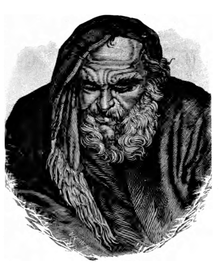
Anania devoted a significant part of his autobiography to Tychicus (born c. 560), with whom he spent eight years in the 620s or 630s.[28][29][30] Tychicus had studied the Armenian language and its literature while serving in the Byzantine army in Armenia.[10][28] Wounded by the Persians, he retired from the military and later studied in Alexandria, Rome, and Constantinople.[10][28] Tychicus later returned to his native Trebizond, where he established a school c. 615.[28]
Tychicus taught many students from Constantinople (including from the imperial court) and was renowned among Byzantine kings.[31][14] He provided Anania special attention and taught him What Anania called a "perfect knowledge of mathematics".[15] In Tychicus's large library, Anania found sacred and secular Greek authors, including works on the sciences, medicine, chronology, and history.[14][28][32] Anania considered Tychicus to have been "predestined by God for the introduction of science into Armenia."[28]
Educator and scientist
Anania himself established a school in Armenia upon his return.[15] That school, the first in Armenia to teach quadrivium, is presumed to have been located in his native Shirak.[8][28] He was disappointed with the laziness of his students and their departure after learning the basics.[28] Anania complained about Armenians' lack of interest in mathematics,[10] writing that they "love neither learning, nor knowledge."[32] The 12th-century chronicler Samuel of Ani listed five of Shirakatsi's students,[8] who are otherwise unknown.[33] Anania financed his research in several fields with the money he earned teaching.[28]
Relationship with the Armenian Church
Anania had a close relationship with the church.[34] Several scholars consider him a church ideologist akin to Cosmas Indicopleustes,[34] whom he actually criticized.[35] Hacikyan describes Anania as a "devout Christian and well versed in the Bible" who "made some attempts to reconcile science and Scripture."[36] In his later years, Anania may have been a monk in the Armenian Church.[9] This is based on his religious discourses and attempts to date the feasts of the church.[37] On the other hand, John A. C. Greppin doubts that Anania was ever in any religious order.[38]
Hewsen noted that some of Anania's "more revolutionary ideas" were suppressed by the Armenian Church after his death.[39] Greppin noted that Anania, a largely secular author, had fallen into a "bad clerical odor."[38] Soviet historians represented him as a founder of irreligious and anti-clerical thought in Armenia, who pioneered double-truth theory.[40] Gevorg Khrlopian went as far as to argue that Anania was an enemy of the Armenian Church and fought against its obscurantism.[34] Hewsen opposed this view, suggesting that, instead, he was an "independent thinker of sorts."[9]
Philosophy
Anania is considered by modern scholars to be a representative of the Hellenizing School since many of his works were based on classical Greek sources.[41][42] He was the first Armenian scholar to have "imported a set of scientific notions, and examples of their applications, from the Greek-speaking schools" into Armenia.[43] He was well versed in Greek literature,[30] and the influence of Greek syntax is evident in his works.[44] Anania was also knowledgeable about native Armenian and Iranian cultural traditions;[14] several of his works provide important information on late Sassanian Iran.[14]
Anania accepted the importance of experience, observation, rational practice and theory, and was influenced by the ideas of the 5th-century Neoplatonist philosopher Davit Anhaght (the Invincible), and Greek philosophers Thales of Miletus, Hippocrates, Democritus, Plato, Aristotle, Zeno of Citium, Epicurus, Ptolemy, Pappus of Alexandria, and Cosmas Indicopleustes.[45] In particular, Aristotle's On the Heavens had a significant influence on Anania's thought.[32] According to Gevorg Khrlopian Anania was heavily influenced by Yeghishe's An Interpretation of Creation, the anonymous Interpretation of the Categories of Aristotle, and the works of Davit Anhaght,[46] who had established Neoplatonism in Armenian thought.[45] Anania was also the first Armenian scholar to quote Philo of Alexandria.[26]
Anania was the last lay scholar in Christian Armenia until Grigor Magistros Pahlavuni in the 11th century.[9][10] He advocated rationalism in studying nature and attacked superstitious beliefs and astrology as the "babblings of the foolish."[47][48] He adopted the classical theory of four elements, which considered all matter to be composed of four elements: fire, air, water, and earth. He believed that while God directly created these elements, He did not interfere with the "natural course of the development of things." He asserted that the creation, existence, and decay of natural bodies and phenomena occurred through the union of these elements—without the interference of God.[49] Both living and non-living matter came into existence from a synthesis of the four elements.[49]
Anania accepted that the Earth is round, describing it as "like an egg with a spherical yolk (the globe) surrounded by a layer of white (the atmosphere) and covered with a hard shell (the sky)."[34] He accurately explained solar and lunar eclipses, the phases of the moon, and the structure of the Milky Way,[47] describing the latter as a "mass of dense but faintly luminous stars."[34] Anania also correctly attributed tides to the influence of the moon.[39][48] He described the topmost sphere as the aether (arp'i), the source of light and heat (through the sun).[50]
Works
Anania was a polymath and natural philosopher.[27][14][15] About 40 works in various disciplines have been attributed to Anania, but only half are extant. They include studies and translations in mathematics, astronomy, cosmology, geography, chronology, and meteorology.[8] Many of his works are believed to have been part of K'nnikon (Քննիկոն, from "canon", Greek: Kanonikon), completed circa 666,[8][51] and used as the standard science textbook in medieval Armenia.[2][52] According to Greenwood, the K'nnikon was a "fluid compilation, whose contents fluctuated over time, reflecting the interests and resources of different teachers and practitioners."[53]
Modern scholars have praised Anania's writing as concise, simple, and to the point, retaining the reader's attention and citing examples to illustrate his point.[47][45]
Mathematical
Anania was primarily devoted to mathematics,[2] which he considered the "mother of all knowledge."[8][9] His mathematical books were used as textbooks in Armenia.[10]
Of Anania's several mathematical works, the most important is the book of arithmetic (Համարողութիւն, Hamaroghut’iun or Թւաբանութիւն, T'vabanut'iun),[54] a comprehensive collection of tables on the four basic operations.[47] It is the earliest extant known work of its kind.[8][12] The operations reach up to a total of 80 million, which is the highest number.[12] A possible theoretical part is believed lost.[47]
Problems and Solutions (alternatively translated as On Questions and Answers), a collection of 24 arithmetical problems and their solutions, is based on the application of fractions;[47][13] it is the earliest such work in Armenian. Many of its problems allude to real-world situations: six connect to the princely house of Shirak, the Kamsarakans,[12] and at least three to Iran.[14] Greenwood calls the problems "a rich source for seventh-century history whose value has not been sufficiently recognized."[55]
The third work, probably an appendix of the book of arithmetic, is titled Խրախճանականք, Xraxc'anakank', literally "things for festive occasions". It has been translated into English as Mathematical Pastimes,[54] Fun with Arithmetic or Problems for Amusement. It also contains 24 problems "intended for mathematical entertainment in social gatherings."[47] According to Mathews this may be the oldest extant text of its kind.[13]
Numerical notation
For his mathematical works, Anania developed a unique numerical notation based on 12 letters of the Armenian alphabet. For the units, he used the first nine letters of the Armenian script (Ա, Բ, Գ, Դ, Ե, Զ, Է, Ը, Թ), similar to the standard traditional Armenian numerical system. The letters used for 10, 100, and 1000 were also identical to the traditional Armenian system (Ժ, Ճ, Ռ), but all other numbers up to 10,000 were written using these 12 letters. For instance, 50 would be written ԵԺ (5×10) and not Ծ as in the standard system. Thus, the notation is multiplicative-additive as opposed to the ciphered-additive standard system and requires knowing 12 letters, instead of 36, to write numbers less than 10,000. Numbers greater than that could be written using multiplicative combinations of just 2 or 3 signs, but using all 36 letters.[56]
Stephen Chrisomalis believes this system was created by Anania since it only occurs in his works and is not found in Greek, Syriac, Hebrew, or any other alphabetic numeral system.[57] Allen Shaw has argued it was just a variant of the Armenian numerals designed specifically for the representation of large numbers.[58] No other writer used it.[57]
Astronomical
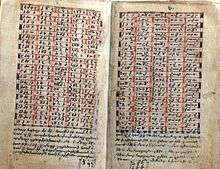
One of Anania's most significant works is Cosmology (Տիեզերագիտութիւն, Tiezeragitut’iun).[59] Abrahamian's version is composed of ten chapters, with an introduction titled "In the Fulfillment of a Promise", implying a patron.[60] It covers the sun, the moon, celestial spheres, constellations, the Milky Way, and meteorological changes.[14][47][61]
Works used for the parts of the Cosmology include the Bible (mostly the Pentateuch and Psalms) and works by the Church Fathers. Anania cites the work of Basil of Caesarea, Gregory the Illuminator, and Amphiolocus (perhaps, of Iconium).[62] Some chapters of the work, such as "On Clouds" (also called "On the Sky" or "Concerning the Skies"), are largely based on Basil's Hexameron.[8][10][62] Anania also repeats the classical Greek notions in the fields of astronomy, physics or meteorology.[63] Pambakian wrote about the significance of the Cosmology:
In conclusion, when viewed as a Byzantine text, the Cosmology's originality may be sought in the way in which pagan and Christian traditions are combined (and often intrinsically intertwined), and much may be learned about the ‘making of science’ in the context of the seventh-century. Within the specific context of Armenian literature, this text deals with many aspects of natural philosophy in unprecedented depth.[64]
Another of Anania's astronomical works, Tables of the Motions of the Moon (Խորանք ընթացիք լուսոյ, xorank‘ ĕnt'ac'ik' lusoy),[54] is based on the works of Meton of Athens and his own observations.[65]
Perpetual calendar
In 667 Anania was invited by Catholicos Anastas I of Akori (r. 661/2–667) to the Armenian Church's central seat at Dvin to establish a fixed calendar of the movable and immovable feasts of the Armenian Church.[10][66] The result was a perpetual calendar based on a 532-year cycle (ՇԼԲ բոլորակ),[2] combining the solar cycle and the lunar cycle since they coincide every 532 years. It was first proposed by Victorius of Aquitaine in 457 and adopted by the Church of Alexandria.[34] Anania's calendar was never implemented by the Armenian Church;[2][10] Hovhannes Draskhanakerttsi believes that Anastas's death prevented a church council from ratifying it.[67]
Geographical
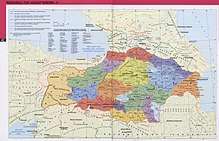
Ashkharhatsuyts[10] (classical Armenian: Աշխարհացոյց, Ašxarhac'oyts, lit. "showing the world") is an anonymously published world map, believed to have been written sometime between 610 and 636.[68] Its authorship has been disputed in the modern period; formerly believed to have been the work of Movses Khorenatsi, most scholars now attribute it to Anania.[2][38][13][69][70] Hewsen calls it "one of the most valuable works to come down to us from Armenian antiquity."[71]
The Armenian Geography—as it is alternatively known—has been especially important for research into the history and geography of Greater Armenia, the Caucasus (Georgia and Caucasian Albania) and the Sasanian Empire,[14] which are all described in detail.[36][71] The territories are described before the Arab invasions and conquests.[18] The information on Armenia is not found elsewhere in historical sources,[13] as it is the only known Armenian geographical work prior to the 13th century.[11]
Ashkharhatsuyts has survived in long and short recensions.[71] According to the scholarly consensus, the long recension was the original.[72] For the description of Europe, North Africa and Asia (all the known world from Spain to China),[13] it largely uses Greek sources, namely the now lost geography of Pappus of Alexandria (4th century), which in turn, is based on the Geography of Ptolemy (2nd century).[2][14][71] According to Hewsen, it is the "last work based on ancient geographical knowledge written before the Renaissance."[34]
It was one of the earliest secular Armenian works to be published (in 1668 by Voskan Yerevantsi).[73] It has been translated into four languages: English, Latin (both 1736), French (1819), and Russian (1877).[74] In 1877, Kerovbe Patkanian first attributed it to Anania as the most probable author.[75]
Another geographical work of Anania, The Itinerary (Մղոնաչափք, Mghonachap'k’ or Młonača'k’), may have been a part of Ashkharhatsuyts. It presents six routes from Dvin, Armenia's capital at that time, to the major settlements in different directions, with distances in miles (մղոն, mghon), referring to the Arabic mile of 1,917.6 metres (6,291 ft), according to Hakob Manandian.[76]
Chronology
Anania's major chronological work, the Chronicle, listed important events in order of their occurrence.[10] Written between 686 and 690, it is composed of two parts: a universal chronicle, utilizing the lost works of Annianus of Alexandria and the lost Roman imperial sequence from Eusebius's Chronographia, and an ecclesiastical history from a miaphysite perspective, which records the six ecumenical councils.[77]
Another chronological work, known as the Tomar (Calendar), included texts and tables about the calendars of 15 peoples: Armenians, Hebrews, Arabs, Macedonians, Romans, Syrians, Greeks, Egyptians, Ethiopians, Athenians, Bythanians, Cappadocians, Georgians, Caucasian Albanians, and Persians.[78][79] The calendars of the Armenians, Romans, Hebrews, Syrians, Greeks, and Egyptians contain texts, while those of other peoples only have the names of months and their length.[80]
Other
Anania wrote several books on weights and measures. He extensively used the work of Epiphanius of Salamis to present the system of weights used by the Greeks, Jews, and Syrians, and his own knowledge as well as other sources for those of the Armenians and Persians.[81][13] Anania wrote several works on precious stones,[37] music, and the known languages of the world.[13] Anania's discourses on Christmas/Epiphany and Easter, which are discussions on the dates of the two feasts. In the first, he uses a lost work he ascribes to Polycarp of Smyrna and insists that the Armenian custom of celebrating Christmas and the Epiphany on the same date is truer to the holidays' intent than celebrating them separately as is common elsewhere in the Christian world.[37][54]
Legacy
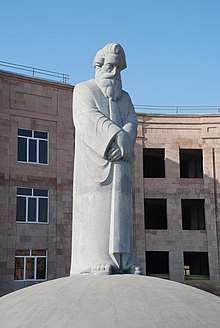
Influence in the Middle Ages
Anania laid the foundations of the exact sciences in Armenia and greatly influenced many Armenian scholars who came after him.[36][lower-alpha 4] Hovhannes Imastaser (Hovhannes Sarkavag) and other medieval scholars extensively cited and incorporated Anania's works.[45] In a 1037 letter, Grigor Magistros, a scholar from the Pahlavuni noble family, asked Catholicos Petros Getadardz for Anania's manuscripts of his K’nnikon, which were locked up at the catholicosate for centuries.[83][84] Grigor used these as a textbook at his school at the Sanahin Monastery.[85]
Reemergence in the modern period
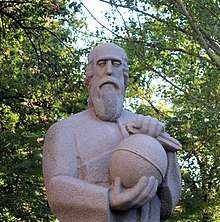
In the print age, passing references to Anania were made as early as 1742 (by Paghtasar Dpir), but it was not until the latter half of the 19th century that Anania and his work became a subject of study.[86] In 1877 Armenian linguist and philologist Kerovbe Patkanian published a collection of Anania's works in the original classical Armenian at Saint Petersburg University.[87] Titled Sundry Studies (Մնացորդք բանից, Mnatsordk’ banits),[88] it is the first-ever print publication of his works.[36] Galust Ter-Mkrtchian published a number of Anania's works in 1896.[87] Joseph Orbeli, an Armenian member of the Russian Academy of Sciences, published a Russian translation of Anania's Problems and Solutions in 1918.[87]
Systematic study and publication of his works began in the Soviet period.[87] Ashot G. Abrahamian, who began his research at the Matenadaran in the 1930s, first published one of Anania's arithmetical texts in 1939,[87] followed by a complete compilation of Anania's work in 1944.[89]
Abrahamian's work was not received with universal acclaim. One critic objected to his 1944 compilation for attributing disputed works to Anania.[90] Abrahamian and Garegin Petrosian published an updated edition in 1979.[91] Some criticism persisted: Varag Arakelian noted a number of errors in translations from classical Armenian and concluded that a new translation of Anania's works was needed.[92] Another Soviet scholar, Suren T. Eremian, studied the Geography. He insisted on Anania's authorship and published his research in 1963.[93]
The first translation of Anania's work into a Western language was done by the British Orientalist Frederick Cornwallis Conybeare, who translated into English Anania's On Christmas, in 1896, and On Easter and Anania's autobiography, in 1897.[94][87] Lemerle noted that Conybeare translated Anania's autobiography from a Russian translation, and it contains numerous serious errors.[95] Renewed interest in Anania's work emerged in the West in the 1960s. A French translation of his autobiography appeared in 1964 by Haïg Berbérian.[96] Robert H. Hewsen authored an introductory article on Anania's life and scholarship in 1968.[97]
Greenwood argues that studying Anania and his works "resonated with twentieth-century political beliefs and offered a suitable subject for academic research in ways that works on medieval theology or Biblical exegesis did not. Anania came to be projected as a national hero from the distant Armenian past, linking and affirming past and present identities."[98]
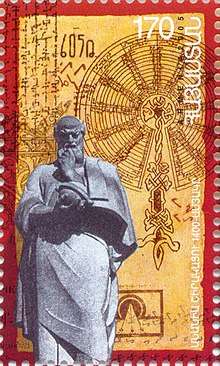
Modern assessment
Anania is considered by modern scholars as the "father of the exact sciences in Armenia."[26][8][1][95] Modern historians consider him as the greatest scientist of medieval Armenia[1][6] and, possibly, all Armenian history, up to the 20th century astrophysicist Viktor Ambartsumian.[lower-alpha 5][99] He is widely regarded as the founder of the natural sciences in the country.[40] He was the first classical Armenian scholar to study mathematics and several scientific subjects, such as cosmography and chronology.[17][95] Hacikyan et al. wrote in The Heritage of Armenian Literature:
Shirakatsi was an educator and an organizer of ideas and materials rather than an original thinker. He was often in the forefront of scientific thinking, but at other times he repeated the accepted theories of his time.[36]
Shirakatsi was one of six scholars whose statue was erected in front of the Matenadaran, the museum-institute of Armenian manuscripts in Yerevan, in the 1960s.[100] Another statue was erected in the front yard of the Yerevan State University. A crater on the Moon was named after Shirakatsi in 1979.[lower-alpha 6]
In independent post-Soviet Armenia, Anania Shirakatsi has been commemorated in various ways. In 1993 the Medal of Anania Shirakatsi, a state award, was established, given for "significant activities, inventions, and discoveries in the spheres of economy, engineering, architecture, science, and technology." In 2005 the Central Bank of Armenia issued a commemorative coin, while HayPost issued a stamp dedicated to Anania Shirakatsi.[lower-alpha 7]
References
- Notes
- His name is usually anglicized as Ananias of Shirak (Širak).[1][2] Anania is the Armenian variant of the biblical name Ananias, itself the Greek version of the Hebrew Hananiah.[3] The second part of his name denotes his place of origin, the region of Shirak (Širak),[1] though it may have become a sort of surname.[4] In some manuscripts, he is called Shirakuni (Շիրակունի) and Shirakavantsi (Շիրակաւանցի).[4][5][6][7]
- He will be referred to by this name throughout this article, as surnames were not widely used in Armenia at the time
- or Tukhikos[8] Greek: Τύχικος, Classical Armenian: Տիւքիկոս
- These include Hovhannes Draskhanakerttsi (d. 925),[36] Anania of Narek (d. 980s),[13] Grigor Magistros (d. 1058),[13] Stepanos Asoghik (11th century),[36] Hovhannes Kozern (11th century),[13] Hovhannes Imastaser (Sarkavag) (d. 1129),[82][45][13][36] Nerses Shnorhali (d. 1173),[82] Samuel Anetsi (12th century),[82][13] Vanakan (d. 1250),[45] Kirakos Gandzaketsi (d. 1271),[36] Hovhannes Erznkatsi (d. 1293),[82][13] Grigor Tatevatsi (d. 1410),[13] and Hakob Ghrimetsi (d. 1426).[82]
- Avagyan, Sona (5 October 2010). "Ոչ ոք չէր նկատել, որ Շիրակացու 1400-ամյակն է". Hetq (in Armenian). Archived from the original on 6 December 2019.
- Gazetteer of Planetary Nomenclature 1994 (PDF). U.S. Geological Survey. 1995. p. 78.
- "Republic of Armenia: Medal of Anania Shirakatsi". medals.org.uk. Medals of the World.
"The Medal of Anania Shirakatsi". president.am. The Office to the President of the Republic of Armenia.
"Collector Coins: 2005 - Anania Shirakatsi". cba.am. Central Bank of Armenia.
"2005 – Armenian Stamps Stamps of Armenia Հայկական նամականիշեր". armenianstamps.org.
- Citations
- Hewsen 1968, p. 32.
- van Lint 2018, p. 68.
- Acharian 1942, p. 148.
- Hayrapetian 1941, p. 3.
- Vardanyan 2013, p. 9.
- Broutian 2009, p. 2.
- Abeghian 1944, p. 374.
- Mathews, Jr. 2008a, p. 70.
- Hewsen 1968, p. 34.
- Thomson 1997, p. 221.
- Thomson 1997, p. 222.
- Hewsen 1968, p. 42.
- Mathews, Jr. 2008a, p. 71.
- Greenwood 2018.
- Hacikyan et al. 2002, p. 56.
- Sarafian 1930, p. 99.
- Thomson 1997, p. 220.
- Hewsen 1992, p. 15.
- Vardanyan 2013, p. 17.
- Greenwood 2011, p. 142.
- Acharian 1942, p. 149.
- Tumanian et al. 1974, p. 362.
- Greenwood 2011, p. 144.
- Hayrapetian 1941, p. 4.
- Greenwood 2011, p. 145.
- Terian 1980, p. 180.
- Pambakian 2018, p. 11.
- Hewsen 1968, p. 35.
- Greenwood 2011, p. 179.
- Vasiliev 1945, p. 492.
- Hewsen 1968, pp. 34-35.
- Terian 1980, p. 181.
- Greenwood 2011, p. 157.
- Hewsen 1968, p. 36.
- Hewsen 1968, pp. 36-37.
- Hacikyan et al. 2002, p. 58.
- Hewsen 1968, p. 45.
- Greppin 1995, p. 679.
- Hewsen 1968, p. 38.
- Tumanian et al. 1974, p. 364.
- Mathews, Jr. 2008b, p. 365.
- Adontz 1970, p. 163.
- Pambakian 2018, p. 9.
- Terian 1980, p. 182.
- Hewsen 1968, p. 40.
- Khrlopian 1964, p. 178.
- Hacikyan et al. 2002, p. 57.
- Jeu 1973, p. 252.
- Hewsen 1968, p. 37.
- Hewsen 1968, p. 37-38.
- Hewsen 1992, p. 14.
- Broutian 2009, p. 4.
- Greenwood 2011, p. 136.
- Pambakian 2018, p. 13.
- Greenwood 2011, p. 177.
- Chrisomalis 2010, pp. 175-176.
- Chrisomalis 2010, p. 177.
- Shaw 1939.
- Pambakian 2018, p. 10.
- Pambakian 2018, p. 14.
- Pambakian 2018, p. 15.
- Pambakian 2018, p. 16.
- Pambakian 2018, p. 17.
- Pambakian 2018, p. 22.
- Hewsen 1968, p. 41.
- Hewsen 1968, pp. 35-36.
- Greenwood 2011, p. 131.
- Hewsen 1992, p. 13.
- Hewsen 1992.
- Pambakian 2018, p. 12.
- Hewsen 1992, p. 1.
- Greppin 1995, pp. 679-680.
- Hewsen 1992, p. 4.
- Hewsen 1992, pp. 4-5.
- Hewsen 1992, p. 8.
- Hewsen 1968, p. 44.
- Greenwood 2008, p. 197.
- Broutian 2009, p. 5.
- Hewsen 1968, pp. 44-45.
- Broutian 2009, pp. 8-9.
- Hewsen 1968, pp. 43-44.
- Abrahamian & Petrosian 1979, p. 23.
- Matevosian 1994, pp. 17-18.
- Greenwood 2011, p. 133.
- Matevosian 1994, p. 21.
- Gyulumyan 2012, pp. 6, 9.
- Hewsen 1968, p. 33.
- Patkanian 1877.
- Abrahamian 1944.
- Simyonov 1947, pp. 97-100.
- Abrahamian & Petrosian 1979.
- Arakelian 1981, p. 300.
- Eremian 1963.
- Conybeare 1897.
- Lemerle 2017, p. 90.
- Berbérian 1964.
- Hewsen 1968.
- Greenwood 2011, p. 134.
- Danielyan 2008, p. 256.
- Greenwood 2011, p. 135.
Bibliography
Books on Anania
- Patkanian, Kerovbe (1877). Մնացորդք բանից (in Armenian). Saint Petersburg University.CS1 maint: ref=harv (link)
- Abrahamian, Ashot G. (1944). Անանիա Շիրակացու մատենագրությունը (in Armenian). Yerevan: Armenian SSR Matenadaran Press.CS1 maint: ref=harv (link)
- Abrahamian, Ashot G.; Petrosian, Garegin B. (1979). Անանիա Շիրակացի․ Մատենագրություն [Anania Shirakatsi: Writings] (in Armenian). Yerevan: Sovetakan grogh.CS1 maint: ref=harv (link) online
- Eremian, Suren (1963). Հայաստանը ըստ "Աշխարհացոյց"-ի (in Armenian). Yerevan: Armenian Academy of Sciences Press.CS1 maint: ref=harv (link)
- Gyulumyan, O., ed. (2012). Անանիա Շիրակացի: Կենսամատենագիտություն [Anania Shirakatsi: Bibliography] (in Armenian). Yerevan: National Library of Armenia. ISBN 978-99930-65-86-9.CS1 maint: ref=harv (link) PDF (archived)
- Hewsen, Robert H. (1992). The Geography of Ananias of Širak. Wiesbaden: Dr. Ludwig Reichert Verlag.CS1 maint: ref=harv (link)
General books
- Adontz, Nicholas (1970). Armenia in the Period of Justinian. Nina Garsoïan (trans.). Lisbon: Calouste Gulbenkian Foundation.CS1 maint: ref=harv (link)
- Lemerle, Paul (2017) [1971]. Byzantine Humanism: The First Phase [Le premier humanisme byzantin]. Lindsay Helen, Ann Moffatt (trans.). Leiden: BRILL. pp. 90–94. ISBN 9789004344594.CS1 maint: ref=harv (link)
- Sarafian, Kevork A. (1930). History of Education in Armenia. Press of the La Verne Leader.CS1 maint: ref=harv (link)
- Acharian, Hrachia (1942). Հայոց անձնանունների բառարան [Dictionary of Personal Names] Vol. 1 (in Armenian). Yerevan State University. pp. 148-149.CS1 maint: ref=harv (link)
Book chapters on Anania
- Mathews, Jr., Edward G. (2008a). "Anania of Shirak". In Keyser, Paul T.; Irby-Massie, Georgia L. (eds.). Encyclopedia of Ancient Natural Scientists: The Greek Tradition and its Many Heirs. Routledge. pp. 70-71. ISBN 9781134298020.CS1 maint: ref=harv (link)
- Hacikyan, Agop Jack; Basmajian, Gabriel; Franchuk, Edward S.; Ouzounian, Nourhan (2002). "Anania Shirakatsi (Anania of Shirak)". The Heritage of Armenian Literature: From the sixth to the eighteenth century. Detroit: Wayne State University Press. pp. 56-80. ISBN 9780814330234.
- Thomson, Robert W. (1997). "Armenian Literary Culture Through the Eleventh Century". In Hovannisian, Richard G. (ed.). The Armenian People from Ancient to Modern Times: Volume I: The Dynastic Periods: From Antiquity to the Fourteenth Century. New York: St. Martin's Press. pp. 199–240.CS1 maint: ref=harv (link)
- van Lint, Theo (2018). "Ananias of Shirak (Anania Shirakats'i)". In Nicholson, Oliver (ed.). The Oxford Dictionary of Late Antiquity. Oxford University Press. p. 68. ISBN 978-0-19-881624-9.CS1 maint: ref=harv (link)
- Chrisomalis, Stephen (2010). "Shirakatsi's Notation". Numerical Notation: A Comparative History. Cambridge University Press. pp. 175-177. ISBN 9780521878180.CS1 maint: ref=harv (link)
- Mathews, Jr., Edward G. (2008b). "Hellenizing School (Arm. Yunaban Drpoc; ca 570 - ca 730)". In Keyser, Paul T.; Irby-Massie, Georgia L. (eds.). Encyclopedia of Ancient Natural Scientists: The Greek Tradition and its Many Heirs. Routledge. ISBN 9781134298020.CS1 maint: ref=harv (link)
- Terian, Abraham (1980). "The Hellenizing School: Its Time, Place, and Scope of Activities Reconsidered". In Nina Garsoïan, Thomas F. Mathews, Robert W. Thomson (eds.). East of Byzantium: Syria and Armenia in the Formative Period. Washington, D.C.: Dumbarton Oaks. pp. 175-186.CS1 maint: uses editors parameter (link) CS1 maint: ref=harv (link)
- Abeghian, Manuk (1944). "Անանիա Շիրակացի [Anania Shirakatsi]". Հայոց Հին Գրականության Պատմություն [History of Ancient Armenian Literature] (in Armenian). Yerevan: Armenian SSR Academy of Sciences. pp. 373-387.CS1 maint: ref=harv (link)
Encyclopedia articles
- Greenwood, Timothy William (9 April 2018). "Ananias of Shirak (Anania Širakac'i)". Encyclopædia Iranica.CS1 maint: ref=harv (link) online
- Tumanian, B.; Matevosian, A.; Chaloyan, V.; Abrahamian, A.; Tahmizian, N. (1974). "Անանիա Շիրակացի [Anania Shirakatsi]". Soviet Armenian Encyclopedia Volume I (in Armenian). pp. 362-364.
Journal articles
- Conybeare, F. E. (1897). "Ananias of Shirak (A. D. 600—650 c.)". Byzantinische Zeitschrift. 6 (3): 572–584. doi:10.1515/byzs.1897.6.3.572.CS1 maint: ref=harv (link)
- Hewsen, Robert H. (1968). "Science in Seventh-Century Armenia: Ananias of Širak". Isis. History of Science Society. 59 (1): 32–45. doi:10.1086/350333. JSTOR 227850.CS1 maint: ref=harv (link)
- Vasiliev, Alexander (1945). "Reviewed Work: Armenia and the Byzantine Empire. A Brief Study of Armenian Art and Civilization by Sirapie Der Nersessian". Speculum. 20 (4): 492. JSTOR 2856749.CS1 maint: ref=harv (link)
- Simyonov, L. (1947). "Պրոֆ. դոկտոր Ա. Աբրահամյան. – "Անանիա Շիրակացու մատենագրությունը"։ Երևան, Հայպետհրատ, 1944 թ." Bulletin of the Academy of Sciences of the Armenian SSR: Social Sciences (in Armenian) (3): 97–100.CS1 maint: ref=harv (link)
- Arakelian, V. D. (1981). "Անանիա Շիրակացի, Մատենագրություն, թարգմանությունը, աոաջաբանը և ծանոթագրությունները Ա. Գ. Աբրահամյանի և Գ. Բ. Պետրոսյանի, Երևան, 1979 [Ananya Shirakatsi: Selected Works, transl. by A. G. Abrahamian and G. B. Petrossian]". Patma-Banasirakan Handes (in Armenian) (4): 295–300.CS1 maint: ref=harv (link)
- Berbérian, Haïg (1964). "Autobiographie d'Anania Sirakac'i". Revue des Études Arméniennes (in French) (1): 189–194.CS1 maint: ref=harv (link)
- Shaw, Allen A. (1939). "An Overlooked Numeral System of Antiquity". National Mathematics Magazine. Mathematical Association of America. 13 (8): 368–372. doi:10.2307/3028489. JSTOR 3028489.CS1 maint: ref=harv (link)
- Jeu, Bernard (1973). "A Note on Some Armenian Philosophers". Studies in Soviet Thought. Springer. 13 (3/4): 251–264. doi:10.1007/BF01043876. JSTOR 20098573.CS1 maint: ref=harv (link)
- Pambakian, Stephanie (2018). "Tradition and Innovation in the Cosmology of Anania Širakac'i" (PDF). Eurasiatica. Edizioni Ca’ Foscari. 11: 9–24. doi:10.30687/978-88-6969-279-6/001. ISBN 978-88-6969-280-2. Archived from the original on 2019-04-12. Retrieved 2019-03-30.CS1 maint: ref=harv (link) CS1 maint: BOT: original-url status unknown (link)
- Matevosian, Artashes (1994). "Գրիգոր Մագիստրոսը և Անանիա Շիրակացու "Քննիկոնը"" (PDF). Banber Matenadarani (in Armenian). Matenadaran (16): 16–30.CS1 maint: ref=harv (link)
- Greenwood, Tim (2011). "A Reassessment of the Life and Mathematical Problems of Anania Širakac'i". Revue des Études Arméniennes. 33: 131–186.CS1 maint: ref=harv (link)
- Greppin, John A. C. (1995). "Comments on Early Armenian Knowledge of Botany as Revealed in the Geography of Ananias of Shirak". Journal of the American Oriental Society. 115 (4): 679–684. doi:10.2307/604736. JSTOR 604736.CS1 maint: ref=harv (link)
- Hayrapetian, S. (1941). "Անանիա Շիրակացու կյանքն ու գործունեությունը [Life and career of Anania Shirakatsi]" (PDF). Banber Matenadarani (in Armenian). Matenadaran (1).CS1 maint: ref=harv (link)
- Vardanyan, Vahram (2013). "Անանիա Շիրակացին' հայոց հոգևոր և քաղաքական ինքնուրույնության ջահակիր [Anania Shirakatsy, the Armenian Symbol of Spiritual and Political Self-Sufficiency]". Lraber Hasarakakan Gitutyunneri (in Armenian) (3): 9–19.CS1 maint: ref=harv (link)
- Greenwood, Tim (2008). ""New Light from the East": Chronography and Ecclesiastical History through a Late Seventh-Century Armenian Source". Journal of Early Christian Studies. 16 (2): 197–254. doi:10.1353/earl.0.0018.CS1 maint: ref=harv (link)
- Broutian, Grigor (2009). "Persian and Arabic Calendars as Presented by Anania Shirkatsi". Tarikh-e Elm. University of Tehran. 7 (1): 1–17.CS1 maint: ref=harv (link)
- Danielyan, Eduard L. (2008). "The Contribution of Academician Victor Hambartsumyan to the History of Armenian and World Cosmological Thought and Astronomy". Lraber Hasarakakan Gitutyunneri (3): 256–259.CS1 maint: ref=harv (link)
Further reading
- Tee, Garry J. (1972). "Two Armenian Savants". Prudentia. University of Auckland. 4 (2).
- Mahé, Jean-Pierre (1987). "Quadrivium et cursus d'études au VIIe siècle en Arménie et dans le monde byzantin d'après le "K'nnikon" d'Anania Širakac'i". Travaux et Mémoires (in French). Centre de recherche d'Histoire et Civilisation de Byzance. 10: 159–206.
External links

